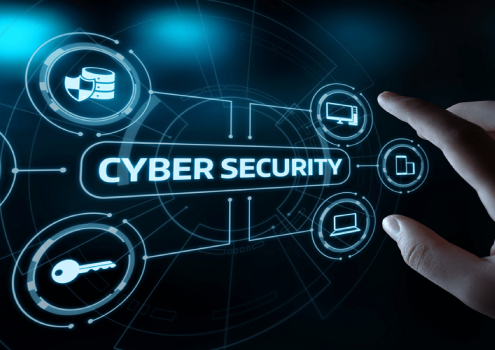Understanding Cybersecurity: The Ultimate Guide for Beginners
In today’s digital age, cybersecurity is more crucial than ever. With the rise of internet usage, mobile technology, cloud computing, and IoT (Internet of Things), our personal and business data are more exposed than ever before. As a result, protecting this data has become an integral part of maintaining privacy and security. Cybersecurity is the practice of safeguarding systems, networks, and sensitive data from cyber threats. In this blog, we’ll explore what cybersecurity is, why it’s essential, the various types of cybersecurity, and how you can protect yourself from digital threats.
Cybersecurity is not a product, but a process; a continuous effort to adapt and protect in a world where threats evolve as quickly as technology.
by Mark LaurenceWhat is Cybersecurity?
Cybersecurity is a broad term that refers to the measures taken to protect computers, servers, mobile devices, electronic systems, networks, and data from malicious attacks. Cyberattacks can result in stolen data, loss of privacy, identity theft, financial damage, and disruption of critical services.
At its core, cybersecurity involves:
- Confidentiality: Ensuring that sensitive data is only accessible to authorized individuals.
- Integrity: Safeguarding data from unauthorized alterations or tampering.
- Availability: Ensuring that systems and data are accessible to users when needed.
Why is Cybersecurity Important?
As businesses, governments, and individuals increasingly rely on digital systems, the potential risks and vulnerabilities also grow. Cyberattacks can lead to:
- Data Breaches: Hackers can steal sensitive information like credit card details, medical records, or intellectual property.
- Financial Loss: Cyberattacks can result in monetary losses due to ransomware, stolen funds, or fraudulent transactions.
- Reputation Damage: A business that experiences a significant data breach may suffer a loss of trust from its customers, clients, or partners.
- Operational Disruption: Attacks can disrupt services, shut down systems, or lock users out of critical functions, impacting productivity.
- Legal Consequences: Failure to protect customer data can lead to legal penalties and fines under data protection laws like GDPR or HIPAA.
As cybercriminals become more sophisticated, it’s crucial to stay informed and implement strong cybersecurity practices to defend against potential threats.
Types of Cybersecurity
Cybersecurity encompasses a variety of strategies and practices, including:
1. Network Security
Network security is the practice of securing a computer network from intruders, whether targeted attackers or opportunistic malware. It involves protecting the underlying networking infrastructure by implementing measures such as firewalls, intrusion detection systems (IDS), and encryption technologies.
2. Information Security
This type of security focuses on protecting the integrity and privacy of data, both in storage and in transit. Information security protocols help ensure that sensitive data like financial records, health data, and intellectual property are secure from unauthorized access or disclosure.
3. Application Security
Application security refers to measures taken during the development and design phase of applications to prevent vulnerabilities. As applications are increasingly available over various networks, ensuring they are built securely helps minimize the chances of unauthorized access or data breaches.
4. Cloud Security
As organizations move their infrastructure and data to the cloud, cloud security has become paramount. Cloud security involves policies, controls, and technologies designed to protect cloud-based systems, data, and applications from threats.
5. Identity and Access Management (IAM)
IAM ensures that the right individuals have the appropriate level of access to the right resources within an organization. It involves managing digital identities and controlling how data and resources are accessed.
6. Disaster Recovery & Business Continuity
In the event of a cyberattack or data breach, it’s essential for organizations to have plans in place to quickly recover from the incident. Disaster recovery focuses on restoring data and critical IT infrastructure, while business continuity ensures that operations continue without major disruptions.
7. Incident Response
Incident response involves preparing for and reacting to a cybersecurity event, such as a malware attack or data breach. A strong incident response strategy includes identifying, investigating, mitigating, and reporting on incidents.
Common Cyber Threats
The landscape of cyber threats is constantly evolving as hackers use new techniques to exploit vulnerabilities. Here are some of the most common cyber threats:
1. Malware
Malware is malicious software that includes viruses, worms, ransomware, spyware, and trojans. Once installed, malware can damage or disable systems, steal sensitive information, or lock users out of their devices until a ransom is paid.
2. Phishing
Phishing attacks involve sending fraudulent communications, often through email, that appear to be from a trusted source. These emails aim to trick individuals into sharing sensitive information, such as login credentials or financial details.
3. Ransomware
Ransomware is a type of malware that locks users out of their systems or data until a ransom is paid. These attacks can cause significant disruption, particularly for organizations that depend on constant access to their data.
4. Social Engineering
Social engineering attacks rely on human interaction and deception to manipulate individuals into divulging sensitive information. Common examples include phishing, baiting, and pretexting.
5. Denial of Service (DoS) Attacks
DoS attacks aim to overwhelm a system, network, or service, making it unavailable to users. Attackers use a large amount of traffic to crash the target’s system or network, causing service interruptions.
6. Man-in-the-Middle (MitM) Attacks
In a MitM attack, an attacker intercepts communication between two parties to steal data, inject malware, or manipulate the communication.
How to Protect Yourself: Best Practices for Cybersecurity
Now that we’ve covered the importance of cybersecurity and the types of cyber threats, here are some essential tips to protect yourself:
1. Use Strong Passwords
A strong password is your first line of defense against unauthorized access. Use complex passwords with a mix of letters, numbers, and symbols, and avoid using the same password for multiple accounts.
2. Enable Two-Factor Authentication (2FA)
Two-factor authentication provides an extra layer of security by requiring a second form of verification, such as a code sent to your phone, in addition to your password.
3. Keep Software Updated
Cybercriminals often exploit vulnerabilities in outdated software. Regularly updating your operating system, applications, and antivirus software ensures that you have the latest security patches.
4. Be Wary of Suspicious Emails
Avoid clicking on links or downloading attachments from unknown or untrusted sources. Phishing emails are designed to trick you into revealing sensitive information, so always verify the sender before taking any action.
5. Back Up Your Data
Regularly back up your data to a secure location to minimize damage in case of a cyberattack. This is especially important in the event of a ransomware attack where access to your data may be blocked.
6. Secure Your Network
Use a firewall to protect your network from unauthorized access, and ensure your home Wi-Fi network is encrypted. Avoid using public Wi-Fi for sensitive transactions, as it can be less secure.
7. Educate Yourself and Your Team
Awareness is a powerful tool in the fight against cyber threats. Educate yourself and others about common scams, security best practices, and how to spot potential threats.
The Future of Cybersecurity
As technology continues to advance, the need for robust cybersecurity solutions will grow. Emerging technologies like artificial intelligence, machine learning, and blockchain have the potential to revolutionize cybersecurity by detecting and responding to threats in real-time. However, as cybercriminals develop more sophisticated methods, cybersecurity professionals will need to stay one step ahead.
Conclusion
Cybersecurity is an ever-evolving field that impacts individuals, businesses, and governments alike. Protecting digital assets from cyber threats requires a proactive approach, utilizing strong security practices, and staying informed about the latest trends in cybersecurity. Whether you’re safeguarding personal information or protecting an organization’s infrastructure, cybersecurity should be a top priority in today’s digital world.
By following best practices and staying vigilant, you can help reduce your risk of falling victim to cyberattacks and keep your data secure. Remember, cybersecurity is not just a one-time task but an ongoing process that requires constant attention.









- Cloud (3)
- Cyber Security (3)
- Others (5)
Recent Tweets
- Rule number 1: Don't overthink it https://t.co/T9Vg7b9XuI Sep/12/2019
- Smart OR Stylish? How do you balance design principles with design trends? https://t.co/yBb0HKiksq https://t.co/kR5EhraUuK Sep/10/2019


